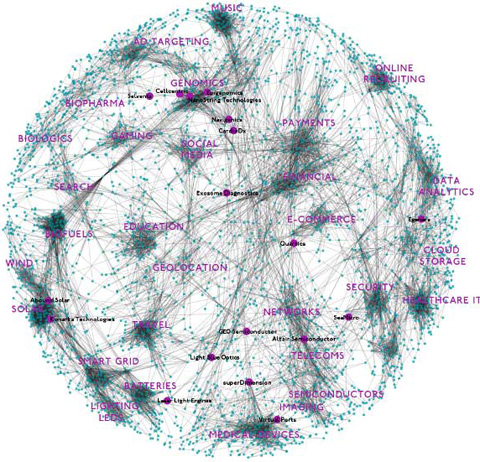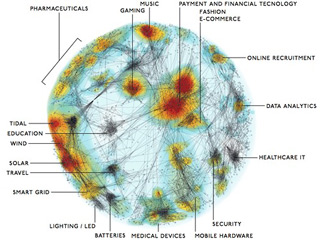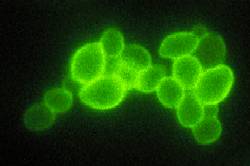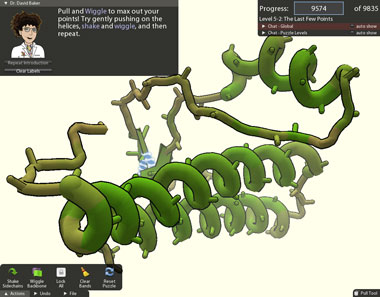Idea Success Analyzer
A unique software product is created in San Francisco. The program creates a map of world progress in the field of human development of various technologies and displays information on promising areas of activity. It is a kind of analyzer for the success of ideas in various business areas.

For 18 months now, the young American company Quid has been mapping the “genome” of technological progress around the world. As explained by Technology Review, Quid has already gathered information to assess the prospects of 35,000 firms and research groups working in the field of new technologies, and, obviously, is not going to dwell on this.
')
An analysis of all these companies seems to be possible only by army of experts. But Quid thinks differently: she created a program that, according to certain algorithms, systematizes knowledge about these companies, their products and experiments.

Quid programs, news, web pages of firms, laboratories, organizations, their press releases, research publications, lists of employees and announced job vacancies, documents on government grants, posts on twitter and so on, are in the field of view of Quid's program. From all this, software extracts key words and phrases that can characterize the main ideas of projects (working groups, start-ups), their belonging to one or another area of knowledge, to one or another technological field.
These key phrases (hundreds per company) can be considered genes. Accordingly, it turns out that each company has its own unique set of technological genes, but, moreover, different companies may have many common genes.
Comparison of such genetic codes sometimes reveals connections that previously escaped attention. Visual visualization in this case helps to find patterns. At the same time, the beams of lines work according to the “principle of gravity” - the more similarity of the threads between companies, the more they attract each other. So similar enterprises and projects form large clusters (engineering, finance, physics, computer science, biochemistry, etc.), which, in turn, are divided into sections.

Comparison of “everything with everything” is a fad of programs. The Quid database grows to 120,000 documents daily. No one person can read them all, which means that they cannot find any patterns, coincidences and intersections - only computers are capable of this. It is they who extract something useful from these tangles of interconnections. Of course, guided by the rules invented by people.
Where do promising innovations come from? What are the trends in the development of technology? Who does this finance? Venture capitalists, who would like to reduce the risk of investing in something new, would appreciate this information.
And although not everything from the field of technology or finance is revealed on the Web, even public information is enough to draw interesting conclusions. Especially if you know what to look for.
Quid is very interested in companies and organizations occupying positions at the junctions of regions. Interesting things often happen here that can potentially turn into breakthroughs. Here again the analogy with nature: the most interesting organisms are hybrids, inheriting genes from markedly different parents. What happens in the end, a viable individual or a dead-end branch of evolution? It's hard to say in advance, but such innovative mixes, according to Quid, are what investors and industrial partners should pay attention to.

Say, what can the biopharmaceutical industry, social media, advertising targeting, gaming and genomics have in common? But in the “white field” somewhere between these very different nodes there were several companies and projects.
So, the American company Insilicos has developed programs for recognition of diagnostic biomarkers in samples, protein analysis, and so on. These tasks required powerful graphics processing tools, which automatically pushed the company Nvidia, actually engaged in electronics, a little closer to the "biology, medicine and pharmaceuticals" sector. For Nvidia, this is a hint of new direction.

The young project Foldit borrowed technology from the gaming industry to solve a purely scientific problem. He invites everyone to compete in ... folding proteins.
For volunteers, this is only a puzzle assembling contest, and the final product is the best methods for folding one or another protein, which are in demand in the pharmaceutical industry. Isolated groups of researchers could not cope with this task, because there are too many options to evaluate, and thousands of people on the web solve this problem literally effortlessly.

Another example of the intersection of themes: platforms for contextual analysis, such as the one that Proximic has, originally invented for advertising targeting, were creatively rethought by Selventa, which with the help of such a device performs a statistical analysis of the response to new drugs in thousands of patients and identifies patterns. And they turn out to be very important for Selventa's partners - companies from the fields of pharmaceuticals, biotechnologies and medical diagnostics.
Another young firm, Vivo, has adapted the ideas of social blogging platforms to create a network for sharing knowledge (results of experiments, ideas) among researchers.
Large white spots between large conglomerates of companies on a technological map are areas where something completely ingenious can potentially be born. You can see this and pay attention only after automatic analysis of thousands of documents. So in the field of view of the program get the originals involved in technological hybridization.
Another striking example is the superDimension company. She came up with a bronchoscopy based on GPS satellite navigation. Three electromagnetic devices that play the role of satellites are placed on the patient's chest, and the probe penetrates the lungs as a navigator.
With the help of the superDimension technique, the doctor can control the position of the probe with high accuracy, and the catheter can be carried out much deeper into the bronchi than with other techniques, and moreover, without damage to the walls of the lungs.

And this is only one point on the "genetic map" of world technologies, and there are already thousands of them on it. The most interesting thing begins when one point after another begins to grow in some white spot.
So we are beginning to form a new sector of the market, attracting engineering forces and money. And although the company's location away from the beaten track is not a guarantee of success, such pioneers are in fact the most loyal supporters of progress.
Interestingly, Quid not only analyzes thousands of projects, but also deals with the analysis of a project of its own. The company continues to improve its program, specifies the data selection algorithms. According to Gourli, on the basis of maps built by Quid, you can already make some predictions now. But in the future they should become even more accurate and deep.

For her project, Quid combined techniques and methods from mathematics, economics, engineering, and linguistics. We can safely say that Quid herself was also born in one of the white spots on the world map of progress. This means that we can hope for the success of an unusual enterprise. So far, Quid has only eight customers. But they are already using the first data from the “technical genome of the planet” program to make decisions in the area of financing new projects.

For 18 months now, the young American company Quid has been mapping the “genome” of technological progress around the world. As explained by Technology Review, Quid has already gathered information to assess the prospects of 35,000 firms and research groups working in the field of new technologies, and, obviously, is not going to dwell on this.
')
An analysis of all these companies seems to be possible only by army of experts. But Quid thinks differently: she created a program that, according to certain algorithms, systematizes knowledge about these companies, their products and experiments.

Quid programs, news, web pages of firms, laboratories, organizations, their press releases, research publications, lists of employees and announced job vacancies, documents on government grants, posts on twitter and so on, are in the field of view of Quid's program. From all this, software extracts key words and phrases that can characterize the main ideas of projects (working groups, start-ups), their belonging to one or another area of knowledge, to one or another technological field.
These key phrases (hundreds per company) can be considered genes. Accordingly, it turns out that each company has its own unique set of technological genes, but, moreover, different companies may have many common genes.
Comparison of such genetic codes sometimes reveals connections that previously escaped attention. Visual visualization in this case helps to find patterns. At the same time, the beams of lines work according to the “principle of gravity” - the more similarity of the threads between companies, the more they attract each other. So similar enterprises and projects form large clusters (engineering, finance, physics, computer science, biochemistry, etc.), which, in turn, are divided into sections.

Comparison of “everything with everything” is a fad of programs. The Quid database grows to 120,000 documents daily. No one person can read them all, which means that they cannot find any patterns, coincidences and intersections - only computers are capable of this. It is they who extract something useful from these tangles of interconnections. Of course, guided by the rules invented by people.
Where do promising innovations come from? What are the trends in the development of technology? Who does this finance? Venture capitalists, who would like to reduce the risk of investing in something new, would appreciate this information.
And although not everything from the field of technology or finance is revealed on the Web, even public information is enough to draw interesting conclusions. Especially if you know what to look for.
Quid is very interested in companies and organizations occupying positions at the junctions of regions. Interesting things often happen here that can potentially turn into breakthroughs. Here again the analogy with nature: the most interesting organisms are hybrids, inheriting genes from markedly different parents. What happens in the end, a viable individual or a dead-end branch of evolution? It's hard to say in advance, but such innovative mixes, according to Quid, are what investors and industrial partners should pay attention to.

Say, what can the biopharmaceutical industry, social media, advertising targeting, gaming and genomics have in common? But in the “white field” somewhere between these very different nodes there were several companies and projects.
So, the American company Insilicos has developed programs for recognition of diagnostic biomarkers in samples, protein analysis, and so on. These tasks required powerful graphics processing tools, which automatically pushed the company Nvidia, actually engaged in electronics, a little closer to the "biology, medicine and pharmaceuticals" sector. For Nvidia, this is a hint of new direction.

The young project Foldit borrowed technology from the gaming industry to solve a purely scientific problem. He invites everyone to compete in ... folding proteins.
For volunteers, this is only a puzzle assembling contest, and the final product is the best methods for folding one or another protein, which are in demand in the pharmaceutical industry. Isolated groups of researchers could not cope with this task, because there are too many options to evaluate, and thousands of people on the web solve this problem literally effortlessly.

Another example of the intersection of themes: platforms for contextual analysis, such as the one that Proximic has, originally invented for advertising targeting, were creatively rethought by Selventa, which with the help of such a device performs a statistical analysis of the response to new drugs in thousands of patients and identifies patterns. And they turn out to be very important for Selventa's partners - companies from the fields of pharmaceuticals, biotechnologies and medical diagnostics.
Another young firm, Vivo, has adapted the ideas of social blogging platforms to create a network for sharing knowledge (results of experiments, ideas) among researchers.
Large white spots between large conglomerates of companies on a technological map are areas where something completely ingenious can potentially be born. You can see this and pay attention only after automatic analysis of thousands of documents. So in the field of view of the program get the originals involved in technological hybridization.
Another striking example is the superDimension company. She came up with a bronchoscopy based on GPS satellite navigation. Three electromagnetic devices that play the role of satellites are placed on the patient's chest, and the probe penetrates the lungs as a navigator.
With the help of the superDimension technique, the doctor can control the position of the probe with high accuracy, and the catheter can be carried out much deeper into the bronchi than with other techniques, and moreover, without damage to the walls of the lungs.

And this is only one point on the "genetic map" of world technologies, and there are already thousands of them on it. The most interesting thing begins when one point after another begins to grow in some white spot.
So we are beginning to form a new sector of the market, attracting engineering forces and money. And although the company's location away from the beaten track is not a guarantee of success, such pioneers are in fact the most loyal supporters of progress.
Interestingly, Quid not only analyzes thousands of projects, but also deals with the analysis of a project of its own. The company continues to improve its program, specifies the data selection algorithms. According to Gourli, on the basis of maps built by Quid, you can already make some predictions now. But in the future they should become even more accurate and deep.

For her project, Quid combined techniques and methods from mathematics, economics, engineering, and linguistics. We can safely say that Quid herself was also born in one of the white spots on the world map of progress. This means that we can hope for the success of an unusual enterprise. So far, Quid has only eight customers. But they are already using the first data from the “technical genome of the planet” program to make decisions in the area of financing new projects.
Source: https://habr.com/ru/post/120162/
All Articles